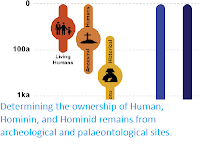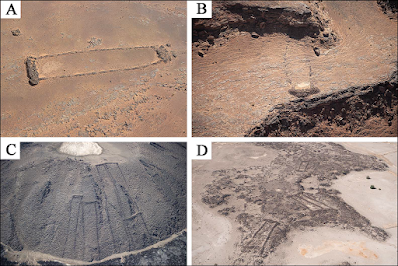Dental caries (the formation of cavities in teeth through decay of the enamel, through the activities of Bacteria) is common in many modern Human populations, and is generally associated with a diet rich in plant-derived foods rich in sugars and starches. The presence of widespread dental caries in Human populations is generally thought to have come about during the Neolithic, when the cultivation of grains was adopted, providing a source of food reliable enough to allow populations to rise and more complex cultures to develop, but at the same time exposing people to the hazards of a starch-rich, grain-based diet. If this is the case, then instances of dental caries should be relatively rare in Pleistocene Humans, as well as in other Hominin species.
Modern dental caries is generally associated with the Bacterium Streptococcus mutans, which thrives in the mouths of people with restricted diets, and less diverse oral microbiotic ecosystems, and which is thought to have become particularly prevailent since the industrial revolution. However, a wide range of Bacteria can cause such damage, and in some cases combinations of Bacteria, which in themselves do little damage, can cause problems. Notably, different types of damage are associated with different Bacterial species, or combinations thereof. Damage is typically caused by Bacteria producing acids which the saliva cannot buffer, resulting in erosion of the tooth material. Some foodstuffs are particularly prone to causing caries, notably products with high levels of refined carbohydrates and sugars, but also some natural foods such as fruits, honey, and some nuts and seeds. Instances of carries are far lower in people with diets rich in tough fibrous foods, which promote saliva formation, as well as diets rich in seafood or meat.
Environmental and genetic factors also appear to play a role in the prevalence of dental caries, although it is unclear how. Different populations with similar diets are known to have different rates of dental caries, although the causes of this are unclear. Instances of caries are well known in both archaeological and fossil dental collections, with the varying prevalence of the condition in different agricultural populations fairly well studied. The condition is also known to affect non-Human Primates, with captive populations more affected than wild populations.
In a paper published in the South African Journal of Science on 29 March 2021, Ian Towle of the Sir John Walsh Research Institute at the University of Otago, Joel Irish of the Research Centre in Evolutionary Anthropology and Palaeoecology at Liverpool John Moores University, and the Evolutionary Studies Institute and Centre for Excellence in PaleoSciences at the University of the Witwatersrand, Isabelle De Groote of the Department of Archaeology at Ghent University, Christianne Fernée of the Department of Anthropology and Archaeology at the University of Bristol, and the Department of Archaeology at the University of Southampton, and Carolina Loch, also of the Sir John Walsh Research Institute at the University of Otago, present the results of a study in which they analysed a range of South African Hominin fossils in the collections of the University of the Witwatersrand and Ditsong National Museum of Natural History, including samples of the recently discovered Homo naledi.
Towle et al. only examined whole teeth, and only considered cases where cavities were clearly present to be evidence for caries; instances of discolouration were considered insufficient evidence due to the nature of the material. Specimens were initially examined with a hand lens, and damage was rated from (1) to (4), using the scheme: (1) enamel destruction only; (2) dentine involvement but pulp chamber not exposed; (3) dentine destruction with pulp chamber exposed; and (4) gross destruction with the crown mostly affected. Finally the location of damage on each tooth was recorded as distal, buccal, occlusal, lingual, mesial, root, or a combination thereof.
The degree of wear (physical abrasion) to each tooth was also recorded, in order to examine the corelation between diet and caries, and to give an estimate of the age of the individuals from which the teeth came (and therefore the age at which they were becoming affected by caries). The front teeth were given a simple wear score from one to eight, with the molars split into four quadrants, each of which was given a wear rating of between one and ten, with an average being used for the whole tooth. Comparisons were made between teeth rather than between individuals, as the majority of the material was in the form of loose teeth, although Towle et al. do recognise that there is a possibility of multiple teeth from the same locarion coming from the same individual, and that it is likely that an individual with caries on one tooth would have it on others.
A subset of the affected teeth were further subjected to computerised tomography scanning at the Department of Human Evolution of the Max Planck Institute for Evolutionary Anthropology, which can differentiate between dentine and enamel, as well as detecting cases of caries where the affected area has reduced density but not obvious cavities.
Prior to Towle et al.'s work, six cases of dental caries had been identified in Hominin specimens from South Africa, and Towle et al. were able to add another four examples to this; two from specimens of Paranthropus robustus, and two from a single individual of Homo naledi. A total of fourteen examples of caries have now been found in ten teeth from seven Homininss. The seven individual Hominins in which dental caries have been diagnosed comprise five Paranthropus robustus, one Homo naledi, and one 'early Homo'. No evidence if dental caries has been found in any example of Australopithecus sediba or Australopithecus africanus.
Homo naledi specimen UW 101-001 shows the worst case of caries ever described in a non-Human Hominin. The cavities present penetrate deep into the dentine, and appear to have been active for a long time. There is no difference in the wear on the teeth affected, suggesting the cavities were not having an impact on mastication function. The cavities are present on the right fourth premolar and first molar, on the surface where these teeth would have faced one-another, implying they had a common cause. In the case of the molar the cavity has expanded to cover much of the occlusal surface, and affected both the root and crown of the tooth. There is sediment present on the surface of the tooth, which accumulated after death, preventing an investigation into how deep the cavity had penetrated into the dentine, and whether it had reached the pulp chamber; it was not possible to subject this specimen to computerised tomography.
Paranthropus robustus mandible SK 23 also shows occlusal caries on two teeth, in this case the left first molar and right second premolar. Both these teeth show large, dark cavities, though again this is partially covered by a matrix of material that had accumulated post-mortem. This sample did not prove particularly amenable to computerised tomography, although the area under the cavities did appear to be less dense, which would support a diagnosis of dental caries.
The number of reported cases of dental caries in non-Human Hominins is low, but represents a significant proportion of the available specimens; 1.36% of all Homo naledi specimens, 1.75% of all Paranthropus robustus specimens, and 4.55% of all 'early Homo' specimens. Four of the seven specimens in which the condition is seen had more wear on the occlusal surfaces of the teeth than the average for such teeth, which may be significant, although most had close to the species average wear levels, and little damage to the crown.
These results suggest that caries may have been more common in pre-agricultural populations than has generally been assumed, and that the condition was relatively common in some South African Hominins, and therefore presumably in Hominins in general. In modern dentistry, visual diagnosis is generally backed up with X-rays, physical probing, and observation of colour changes in teeth, but taphonomic changes make these approaches less useful in palaeontological and archaeological material. Towle et al. were able to examine a small number (five) of specimens by computerised tomography, with mixed results, and it will be necessary to apply this method to more specimens in order to judge how useful in can be.
Bacteria capable of causing caries appear to have been a problem for many, possibly all, Hominin species. This is consistent with recent work which suggests a wide range of Bacteria are capable of causing such damage, either on their own or in concert with other species; in the latter case the Bacteria involved may otherwise be a part of a normal, non-pathological, oral biota. This suggests that the major cause of dental caries is not, in fact the type of Bacteria, but rather the diet of the individual, which in turn implies that we can make judgements about the diets of extinct Hominins by the presence and prevalence of dental caries, although differing oral microbiomes in different Hominin species may have made them more, or less, vulnerable to dental caries under similar conditions.
Caries on the occlusal surfaces of teeth is not associated with high rates of tooth loss, whereas caries on the interproximal surfaces (surfaces that face other teeth) is. Interproximal caries is often associated with the accumulation of plaque in these areas, which does not appear to be a factor in any of the South African Hominins. Enamel hypoplasia (poor formation of the enamel during development) is another major cause of vulnerability to dental caries, and may have been a factor in the cases of the Paranthropus robustus specimens SK 55 and SK 13/14, both of which show substantial hypoplastic pitting; something common in this species.
Dental caries may also develop as a response to damage or unusual wear patterns, which may create weaknesses in the tooth enamel, or spaces in which Bacteria can accumulate safely, and Towle et al. note that this appears to be present in several of the specimens in which they detected the condition.
Chewing on hard items, such as grit in food, can cause damage to teeth which leaves them vulnerable to infection. In Hominins, the interproximal areas of teeth appear to be particularly prone to such damage, unlike in modern Humans, where the occlusal surfaces of the rear teeth are most affected, although the reason for this is unclear.
Modern Human samples, from the last 50 000 years, show levels of caries similar to that detected by Towle et al.; this changes with the adoption of agriculture, and in some populations becomes far more common. An infection rate of 1-5% seems to have been typical for both pre-Human Hominins and Humans leading hunter-gatherer lifestyles. Therefore, the occurence of caries appears to be strongly linked to behaviour and diet, rising in agricultural societies, but also in hunter-gatherer societies with certain diets.
The absence of dental caries observed in Australopithecus africanus is unlikely to reflect a radically different oral microbiome. Instead, this may be a result of a different diet, or simply sampling bias. The presence of the condition in Paranthropus robustus, Homo naledi, and 'early Homo' indicates that these species were consuming foods which made them vulnerable to the condition. Dental caries is also fairly common in species assigned to the genus Homo from elsewhere (including Neanderthals), suggesting that members of the genus have eaten dangerous foods (such as tubers, nuts, plants or fruit) since they first appeared.
See also...



Online courses in Palaeontology.
Follow Sciency Thoughts on Facebook.
Follow Sciency Thoughts on Twitter.









































